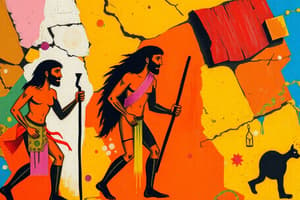Podcast
Questions and Answers
What is the main source of information about the Stone Age in India?
What is the main source of information about the Stone Age in India?
- Archaeological excavations (correct)
- Historical documents
- Oral traditions
- Artifacts found in museums
Which age of the Stone Age in India had evidence of art in the form of paintings?
Which age of the Stone Age in India had evidence of art in the form of paintings?
- Palaeolithic age (correct)
- Mesolithic age
- All of the above
- Neolithic age
Which of the following is NOT a characteristic of the Palaeolithic age in India?
Which of the following is NOT a characteristic of the Palaeolithic age in India?
- Were food gatherers
- Indian people belonged to the 'Negrito' race
- Lived in open air, river valleys, caves and rock shelters
- Had knowledge of houses, pottery, agriculture, and fire (correct)
Which race did Indian people belong to during the Palaeolithic age?
Which race did Indian people belong to during the Palaeolithic age?
Which tools were used during the Middle Palaeolithic age in India?
Which tools were used during the Middle Palaeolithic age in India?
What is the earliest site of Lower Palaeolithic Age in India?
What is the earliest site of Lower Palaeolithic Age in India?
Flashcards are hidden until you start studying
Study Notes
Overview of Stone Age in India
- Stone Age is the prehistoric period before the development of script, and the main source of information is archaeological excavations.
- Robert Bruce Foote discovered the first Palaeolithic tool in India - the Pallavaram handaxe.
- Indian Stone Age is classified into three types: Palaeolithic age, Mesolithic age, and Neolithic age.
- Palaeolithic age or old stone age developed in the Pleistocene period or the Ice Age.
- Main characteristics of Palaeolithic age: Indian people belonged to the 'Negrito' race, lived in open air, river valleys, caves and rock shelters, were food gatherers, and lived on hunting.
- No knowledge of houses, pottery, agriculture, and fire was discovered in later stages.
- Upper Palaeolithic age had evidence of art in the form of paintings.
- Humans used unpolished, rough stones like hand axes, choppers, blades, burins and scrapers.
- The old stone age or Palaeolithic age in India is divided into three phases.
- Lower Palaeolithic Age covered the greater part of the Ice Age, tools used were hand axes, choppers and cleavers, and one of the earliest sites is Bori in Maharashtra.
- Middle Palaeolithic age had tools like flakes, blades, pointers, scrapers and borers, and the tools were smaller, lighter and thinner.
- Upper Palaeolithic age coincided with the last phase of the ice age when the climate became warmer, and the period is marked by innovation in tools and technology with a lot of bone tools.
Overview of Stone Age in India
- Stone Age is the prehistoric period before the development of script, and the main source of information is archaeological excavations.
- Robert Bruce Foote discovered the first Palaeolithic tool in India - the Pallavaram handaxe.
- Indian Stone Age is classified into three types: Palaeolithic age, Mesolithic age, and Neolithic age.
- Palaeolithic age or old stone age developed in the Pleistocene period or the Ice Age.
- Main characteristics of Palaeolithic age: Indian people belonged to the 'Negrito' race, lived in open air, river valleys, caves and rock shelters, were food gatherers, and lived on hunting.
- No knowledge of houses, pottery, agriculture, and fire was discovered in later stages.
- Upper Palaeolithic age had evidence of art in the form of paintings.
- Humans used unpolished, rough stones like hand axes, choppers, blades, burins and scrapers.
- The old stone age or Palaeolithic age in India is divided into three phases.
- Lower Palaeolithic Age covered the greater part of the Ice Age, tools used were hand axes, choppers and cleavers, and one of the earliest sites is Bori in Maharashtra.
- Middle Palaeolithic age had tools like flakes, blades, pointers, scrapers and borers, and the tools were smaller, lighter and thinner.
- Upper Palaeolithic age coincided with the last phase of the ice age when the climate became warmer, and the period is marked by innovation in tools and technology with a lot of bone tools.
Studying That Suits You
Use AI to generate personalized quizzes and flashcards to suit your learning preferences.




